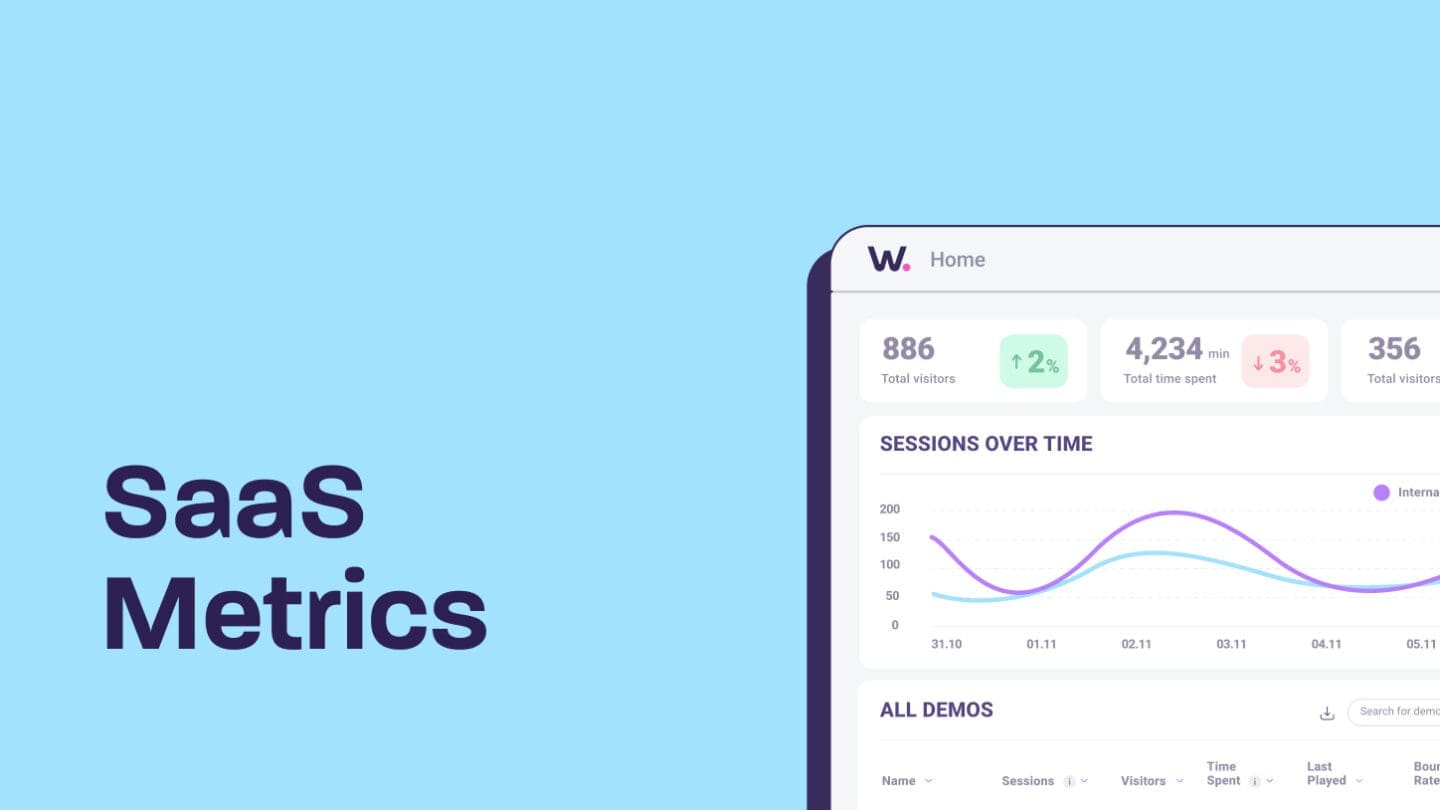Give the people (SaaS buyers) what they want!
And what exactly do they want? To see the product, of course!
For SaaS buyers, the product needs to do the talking, not the sales rep.
To give buyers what they want, more and more often go-to-market (GTM) teams are using a product-led growth (PLG) strategy to drive customer acquisition, expansion, conversion, and retention.
And part of any successful PLG strategy involves creating an amazing demo experience.
Sounds great, right? But building high-quality demo experiences has typically been a serious pain in the ass for sales teams. That’s where a demo experience platform comes in.
In this article, we’ll break down how you can use a demo experience platform to design the best possible demo experience for your customers.
- What is a demo experience?
- Why does the quality of your demo experience matter?
- What causes product demos to fail?
- Not personalizing the demo
- Not reading the room
- Not creating a narrative
- Not watching the time
- What is a demo experience platform?
- Key features of a demo experience platform
- Demo experience platforms benefit the whole company
- Pre-sales team
- Sales team
- Marketing
- Customer success managers
- R&D department
- Using a demo experience platform to deliver a successful experience
- Research prospects before the demo
- Choose the right sales methodology
- Talk to the decision-maker
- Stay on track by using a demo outline
- Work on your sales pitch
- Customize the demo
- Focus on solutions instead of features
- Zero in on pain points
- Tell a story
- Share vital info and use cases
- Make the product demo interactive
- Use analytics to learn from your previous successes and failures
- Take advantage of a demo experience platform
- Provide your prospects with a flawless demo experience
What is a demo experience?
Before we go any further, let’s make sure we know exactly what a demo experience is. And what makes it different from your run-of-the-mill demo.
Anyone in sales is probably familiar with a product demo. But a demo experience encompasses everything from the structure of your demo to the content you include and the platform you use to deliver it.
If done right, a demo experience should help the prospect understand the product flow, the value the product adds, and how it can be integrated into their current workflow.
Why does the quality of your demo experience matter?
The fate of your deal depends on the demo experience.
A little dramatic, but we really can’t understate the importance of the demo experience.
The demo experience is the prospect’s first impression of the product, so you’ll need to make it count. While a memorable and interactive demo experience can help customers understand the value your product brings, a bad or boring one can spell doom for your deal.
On top of this, demo experiences offer a way for customers to immerse themselves in your product. And it allows sellers to show what their product can do.
There’s another reason, though, you’ll want to fine-tune the demo experience.
Most SaaS companies have competitors. And, chances are, your target buyers have heard the same old product pitches before. Over and over and over again.
A demo experience is your one shot to really differentiate your product and show the buyer something they haven’t seen before. And delivering a high-quality, interactive, and personalized demo experience that addresses your customer’s unique pain points is the best way to drive your message home.
The key takeaway here is that when it comes to converting leads, impactful product demo experiences can be your best weapon.
What causes product demos to fail?
Your prospect booked a demo. Yay!
But there’s still plenty of traps that reps can fall into during this stage of the sales process.
(Sorry, we didn’t mean to rain on this parade.)
There’s no need to worry, though. Many of these demo mistakes can be prevented with the right approach.
Here are a few you’ll want to watch out for:
Not personalizing the demo
Prospects don’t want to hear about every little thing your product can do. They want to understand, and understand quickly, how your product addresses their unique pain points.
Not reading the room
A successful demo is all about getting prospects to care about what you’re saying. So, pay attention to the prospect’s facial expressions, any silences, and listening signs to make sure they are actively engaged.
Not creating a narrative
Telling a story will allow you to speak directly to the customer’s emotions, address customer-specific issues, establish a stronger connection, and break down more complex ideas.
Not watching the time
Like we mentioned before, prospects want to quickly understand what’s in it for them. So, make sure you’re getting the most out of your limited time with a prospect.
Sure, in theory it sounds easy enough. But in practice, creating high-fidelity demos using live environments caused a lot of headaches because of how time-consuming and prone to unexpected issues it was.
Luckily, we now have a better way to create a demo experience. And one that helps you streamline the entire sales process and avoid obstacles like these.
What is a demo experience platform?
Enter the demo experience platform.
This type of SaaS sales tech allows sales teams to create interactive and engaging product demos. And this can help you make a lasting impression on prospects.
With a demo experience platform like Walnut, you can create interactive, engaging, and personalized demos that speak to prospects’ specific needs.
Basically, a demo experience platform allows you to create a carbon copy of your product. Not just the visuals, but also the same level of interactivity. But the demos can be made in a code-free sandbox environment using a visual UI, without having to be coupled to your backend.
This means anyone can use a demo platform to create interactive demos—not just developers.
Key features of a demo experience platform
That’s all well and good. But how do demo experience platforms like Walnut actually enable sales teams to improve the overall experience? Glad you asked!
- Create personalized demos at scale: With this type of platform, you can create and reuse demo templates. All you need to do is change a few details, like the logo or brand name, to tailor an interactive demo for a new prospect.
- Enable codeless editing: Demos can be customized using a simple, visual interface with drag-and-drop and live editing tools. And this eliminates the reliance on developers.
- Boost time-to-value: The beauty of this kind of platform is that there’s no long integration process. So, sales teams can start improving the demo experience immediately.
- Track insights and analytics: A demo experience platform tracks valuable data and metrics to gauge the performance of your demo and team. You can also gain insights into why demos succeed or fail to increase future conversions.
- Create a stable and safe environment: Code-based demos in live environments expose your team to all kinds of issues. But demo experience platforms offer safe, controlled environments that minimize the chance of bugs, downtime, or blue screens of death.
- Encourage sharing and collaboration: A demo experience platform is a single-point-of-contact for all your sales demos. Team members can easily share projects and collaborate on them. And completed demos can also be shared with the outside world using links or embeds.
Demo experience platforms benefit the whole company
By now, it makes sense how a demo experience platform can make sales reps’ lives so much easier. But the cherry on top? It will actually benefit the entire company.
How exactly? Let’s break it down team by team.
Pre-sales team
Everyone wants to save time. Seriously, we can’t think of anyone that doesn’t want to find a little extra time every day.
A demo experience platform allows presales teams to quickly create and share product demos based on ready-made templates.
In the past, sales engineers and solutions engineers had to choose between making only superficial changes to existing demos or going through the time and resource-intensive process of creating new and customized demos from scratch.
Now with a demo experience platform, you can empower sales engineers to deliver highly personalized experiences at scale in a fraction of the time.
Sales team
Using a demo experience platform, creating, sharing, and publishing personalized demos can be done in next to no time. This makes it easier for SDRs and AEs to take more control of the demo process by optimizing demos without outside help.
Marketing
For the marketing team, it’s all about bringing in leads.
And a demo experience platform allows marketers to embed self-guided demos in your website and emails, or anywhere else you engage with first-time leads.
Not only does an early demo capture the attention of leads, but it helps qualify them as well.
Customer success managers
Demo experience platforms also come in handy for customer onboarding and success managers.
For success managers, it’s easy to create interactive tutorials to show users about new features that are relevant for them. And, with on-demand availability, your new customers don’t have to wait for lengthy setups to start the customer onboarding process.
R&D department
Last but definitely not least, there’s something in it for the R&D department, too.
Innovation and progress are vital for staying ahead of competitors and relevant to your target market. And this keeps the R&D department’s hands full!
Provisioning and decommissioning sales demo environments, creating brand new demos from scratch, and having to manually change the underlying code to accommodate customer customizations are extremely time-consuming. This distracts your R&D department from product improvements or the development of new features.
But having a demo experience platform provides sales teams with the ability to develop their own demos. So, there’s no need to trouble R&D, and future product developments can easily be integrated into new demos.
Using a demo experience platform to deliver a successful experience
Now it’s time to put everything we just went over into practice.
The good news is that with a demo experience platform, it’s much easier to start implementing successful demo experiences into your SaaS sales strategy. But you will need to keep a few things in mind to make the demo experiences as impactful as possible:
Research prospects before the demo
When it comes to turning prospects into ready-to-buy customers, it all comes down to personalization.
However, you can only provide tailor-made demo experiences if you understand each prospect.
To prepare for the demo, it can help to ask yourself a few questions about the prospect like: How do they differ from their competitors? What are their unique challenges? What can your solution do for them that others can’t?
Choose the right sales methodology
SPIN, GAP, SNAP, MEDDIC, Sandler Selling, Conceptual Selling—there’s no shortage of sales methodologies or models.
Sticking to a sales methodology will ensure your team works together toward the same goal. It also helps everyone understand what they need to do and how they need to do it, so your team can work more efficiently.
Talk to the decision-maker
To get the deal done, there might be multiple people that’ll need convincing.
Instead of simply having to nurture an individual lead, you have to identify decision-makers as well as navigate and persuade a hierarchy of individuals with different roles in the process.
Stay on track by using a demo outline
You’ve gathered all the information you can about the prospect and their needs. Now what?
With all of this information, you’ll want to create a detailed sales presentation outline. Formalizing a demo outline will help you manage scope and focus on key pain points as you craft the demo experience.
Work on your sales pitch
A prospect can’t have a demo experience unless they agree to an in-depth demo presentation. And this is where your elevator sales pitch comes into play.
In one minute or less, you need to explain the value that your product brings. When done right, the sales pitch will convince the customer that they should give you their full attention.
Customize the demo
Customizing your demo for each prospect will help you show the value your product will bring them. And show them faster, for that matter.
This doesn’t only involve personalizing the demo with the prospect’s branding. You’ll need to address their specific pain points by focusing on different solutions or use cases.
Focus on solutions instead of features
Prospects don’t want to sit and listen to you blab about every single feature your product has. Plain and simple.
This is why we recommend the solution selling approach. Rather than just explaining each and every one of the features, emphasize how specific features can solve their unique problems.
Zero in on pain points
Why would a prospect be interested in your product? Because they have pain and they want it gone!
If you can demonstrate exactly how your product can relieve that pain, it strongly incentivizes prospects to sign on the dotted line. So, make sure you understand and prioritize your prospect’s pain points according to their severity.
Tell a story
Telling a story your prospect can relate to shows them how your product takes them from point A to point B. Or, from problem to solution. There are many ways to craft a sales story, but you can start by answering these questions:
- Who is the main character/persona?
- What are they trying to do? When? How?
- What problem do they face?
- How can your product solve that problem?
Share vital info and use cases
Time is money.
And your prospects have a limited amount of time to use and explore your demo. So, you should tailor the experience to prioritize the most important use cases for each prospect. However, make sure you still communicate any essential information that can’t be covered in the demo.
Make the product demo interactive
If a prospect is dozing off during the demo, something has gone wrong.
There’s no better way to make the demo experience engaging and immersive than by using interactive demos. It will bring your customer closer to the actual experience of using your product. By design, interactive demos are also more flexible and encourage exploration.
Use analytics to learn from your previous successes and failures
You kicked ass during the demo. You’re a legend!
But there’s always room for improvement.
With the information you gain from your demos, you can keep fine-tuning the experience. For example, analyzing how your prospects click through your demo can help you discover any bottlenecks in your sales process. This way, you can iron out those last few kinks and become a lean, mean, selling machine.
Take advantage of a demo experience platform
You’ve studied your prospect and rehearsed day in and day out.
But when it comes time to demo, the worst happens.
The demo crashes. OH, THE HORROR!
(Again, sorry for the dramatics.)
But product demo fails, crashes, or even the blue screen of death can really derail even the best demo experience. Not to mention create a negative impression of your product.
Compared to code-based demos, a demo experience platform is unable to bug. So you can finally sleep easy.
Provide your prospects with a flawless demo experience
Anyone can give a demo. But offering a meaningful demo experience is what can really make the difference when it comes to closing deals.
More than just another demo, a demo experience is a way for you to make your product stand out and show how it solves your prospect’s specific issues.
And demo experience platforms were designed to help you create exactly these kinds of experiences.
Plus, the fact that demo experience platforms are code-free means your sales team can create and manage all product demos internally. This frees up your R&D team to focus on doing what they do best: creating amazing new products and features.
Some demo experience platforms (*insert shameless Walnut plug) even let you monitor demo experiences so you can make improvements going forward.
The best part? With this type of platform, you’ll have a safe and reliable environment to run demos—minimizing the risk of demo bugs or other really annoying interruptions.
Think of it this way, with a demo experience platform, you’ll be well on your way to creating demo experiences that get prospects to say “yes” to the dress (we meant your product).
Ready to have a life-changing experience with a demo experience platform? Book a meeting with us now by clicking that big purple “Get Started” button on the top of the screen.



